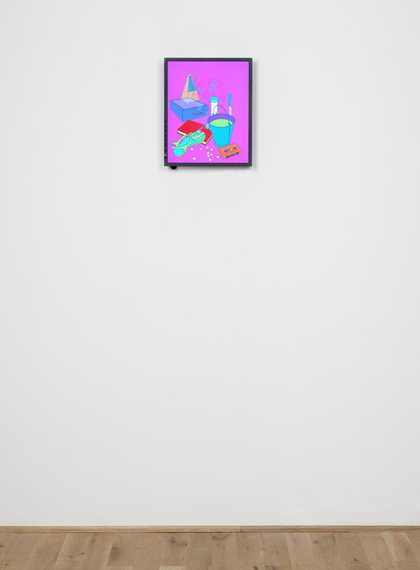
Sir Michael Craig-Martin
Becoming (2003)
Tate
‘As soon as you make a piece of art, you’re an artist.’
– Michael Craig-Martin
At first Craig-Martin’s point might seem plainly obvious – after all, making art is what artists do, right?
But the truth is that most of the time we see it the other way around. Rather than taking someone as an artist because they have made some art, we take the thing we are looking at as ‘art’ because we have been told it has been made by an artist. We look at the label alongside the work, breathing a sigh of relief when we recognise the name – ah, it is by Picasso, we say to ourselves, as if in explanation. Finding ‘anonymous’ on the label is so much less satisfying than seeing a personal name. We need an identifiable artist to know it is art.
I like Craig-Martin’s quotation, not only because I happen to agree with it, but also because it reminds me of a truly great, if difficult, essay on art so full of poetry and insight that you could spend a lifetime reading it and never exhaust its possibilities. The essay is called ‘The Origin of the Work of Art’ (given as a lecture in 1935, and first published in Germany in 1960), by Martin Heidegger.
I don’t understand all of what Heidegger says in this essay, but then I’m not sure it is supposed to be understood, at least logically – it is best read as poetry. At the outset Heidegger says that it is the work of art that ‘gives credit to the master’, enabling them to emerge as an artist. The work of art and the artist exist in a circular relationship, depending on a third, mysterious thing – art itself. You get the sense that he is talking not about the moment of creation, but rather about what happens when works of art emerge into the world – when they are seen and thought about. The famous example he gives is the painting by Van Gogh of a pair of peasant’s boots (probably the painting made in 1886, now in the Van Gogh Museum in Amsterdam), which he takes to show how such a painting reveals not simply the appearance of a thing, but the truth of its very nature. Somehow, works of art create clearings in the world where truth happens. In works of art, as Heidegger puts it, the ‘world worlds’. All art is, in this sense, poetry, an emergence of truth in the world – poetry as a voice raised above the maddening prose of everyday life.
Artists and poets are of course essential for this process – you can’t have art without an artist. But simply being an artist is not enough to ensure that ‘truth happens’ in the way Heidegger hopes. Artists are convenors for art – their ‘greatness’ is incidental, entirely dependent on what they produce. Anyone can make a work of art – and this is Craig-Martin’s point, which he makes in his book On Being an Artist (2015) – regardless of who they are, or what formal qualifications they have, and in doing so become an artist. An element of this becoming is abandoning yourself to the ‘truth’ of art – the fact that it will happen in part without you. The artist is a conduit, or conductor (perhaps like an orchestral conductor), what Heidegger calls a ‘mere’ artist.
It is precisely this view that Marcel Duchamp described in his famous address ‘The Creative Act’. I don’t have a shred of evidence but think Duchamp must have read Heidegger’s essay. In great art, Heidegger argues, ‘the artist remains inconsequential as compared with the work, almost like a passageway that destroys itself in the creative process for the work to emerge’. Duchamp, with his emphasis on the role of the viewer in completing the work, and his own withdrawal from physical creativity – actually making a painting – would surely have agreed.
For all this, when looking at art, we depend overwhelmingly on the presence of the artist’s name – at least I do. Not looking at the wall label is the hardest thing. Yet do we not feel a strange sense of relief when the label is missing? Standing there, the image or object becomes more mysterious, more elusive, more questionable – we feel closer to the work of art without the artist there, as if we might have created it ourselves. Beginning with art, rather than the artist, returns us to the poetry of art.
John-Paul Stonard is a writer and art historian. He is currently writing a book telling the story of art, from Palaeolithic to the present day, for Bloomsbury.
